Space Odyssey
Art Tower Mito, Japan, Feb 10 - May 6, 2001
Holograms can deceive, straining the ordinary distinction between object and image, real and recorded.
Defining what one sees in a hologram has intrigued us since we first began using this medium nearly twenty years ago. The tensions between what is an illusion and what can be seen as real can even exist within the hologram itself.
Such ideas were in our minds in 1987 when we took up the post as artists in residence with the Royal Greenwich Observatory. The Observatory was founded in 1675, making it the oldest scientific institution in Britain.
Defining what one sees in a hologram has intrigued us since we first began using this medium nearly twenty years ago. The tensions between what is an illusion and what can be seen as real can even exist within the hologram itself.
Such ideas were in our minds in 1987 when we took up the post as artists in residence with the Royal Greenwich Observatory. The Observatory was founded in 1675, making it the oldest scientific institution in Britain.
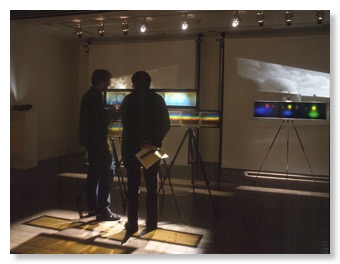
'Airy's Discs' (r) and holograms by Wenyon & Gamble in 'Space Odyssey', Art Tower Mito, 2001
For most of its history, astronomy has depended on interpreting optical images, as seen through telescopes. In the optical realm the physical basis of holography––light––overlaps with that of astronomy. We decided to make the science of light the subject of our investigations. Rather than comment directly on the aesthetics of nature as revealed by science––the beauty of the cosmos––we set out to explore the conceptual processes of science and their visual manifestations.
The scientific study of optical instruments began in the 17th century, motivated largely by the desire to improve the telescope. Sir Isaac Newton's 'Opticks' was published in 1704, and the Observatory's archives contained a first-edition copy presented by the author. Like an artist making studies, much of it is speculative experimentation, often inconclusive. He describes, for example, how he focused a beam of sunlight through holes, lenses or prisms, throwing patterns and colours on a paper screen.
The scientific study of optical instruments began in the 17th century, motivated largely by the desire to improve the telescope. Sir Isaac Newton's 'Opticks' was published in 1704, and the Observatory's archives contained a first-edition copy presented by the author. Like an artist making studies, much of it is speculative experimentation, often inconclusive. He describes, for example, how he focused a beam of sunlight through holes, lenses or prisms, throwing patterns and colours on a paper screen.
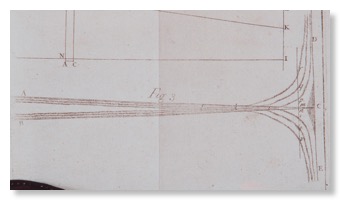
Drawing of the knives' shadows in Newton's Opticks
We decided to use Newton's technical observations as a starting point for an aesthetic investigation in holography. The phenomena of light interference and diffraction, which were behind many of Newton's experiments, are the basic properties which enable the hologram to work.
Sir George Airy (1801–1892) gave his name to an optical form called Airy's Discs, a disc with rings around it, that appears as the optical image of a star in a telescope. It is an effect of diffraction.
Using these forms in holograms, we aim to invest these images with a peculiar power of allusion.
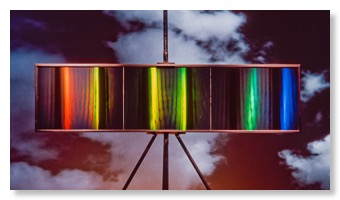
'The Fringes of the Shadows of the Knives', Wenyon & Gamble, 1987, hologram on easel with photo projection
'The Stars, Edinburgh, circa 1970' [right]
Viewing this hologram is like looking at negatives on a light box. The circular glass discs are astronomical negatives, several millimeters thick, photographs of the stars taken through a telescope.
The image is an illusion: the hologram recorded the astronomical photographs taped to the plate, yet the tape and circular plates––appearing in detail as three dimensional––are a reality, a few millimeters deep, that is no longer there.
In these 'illusory' negatives, the stars take on the form of black dots, like bacteria. In some they appear like flies, where the stars have been photographed through a prism.
Viewing this hologram is like looking at negatives on a light box. The circular glass discs are astronomical negatives, several millimeters thick, photographs of the stars taken through a telescope.
The image is an illusion: the hologram recorded the astronomical photographs taped to the plate, yet the tape and circular plates––appearing in detail as three dimensional––are a reality, a few millimeters deep, that is no longer there.
In these 'illusory' negatives, the stars take on the form of black dots, like bacteria. In some they appear like flies, where the stars have been photographed through a prism.
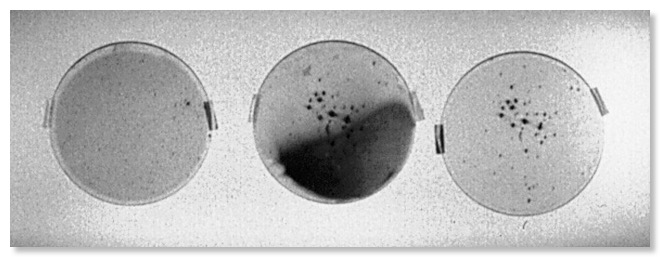
'The Stars, Edinburgh, circa 1970', Wenyon & Gamble, 1994, hologram
"The Colour of the Stars, Edinburgh, circa 1940" [right] These tiny glass photographic plates record the spectrum, or colours, of the light from stars. This data gives the temperature of the stars and contains the colours emitted by different atoms inside of them.
We selected these photographs from an archive at the Royal Observatory Edinburgh in 1994, where we worked for a year as artists in residence.
Wenyon & Gamble
March 2001
We selected these photographs from an archive at the Royal Observatory Edinburgh in 1994, where we worked for a year as artists in residence.
Wenyon & Gamble
March 2001
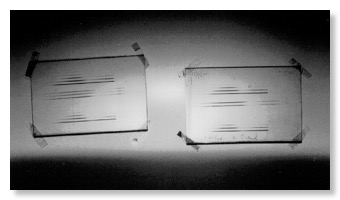
"The Colour of the Stars, Edinburgh, circa 1940", Wenyon & Gamble, hologram, 1994
